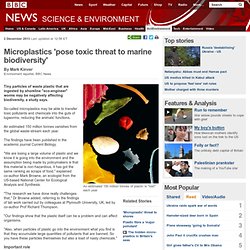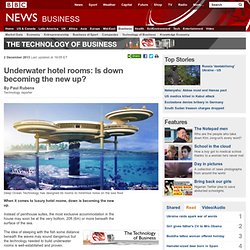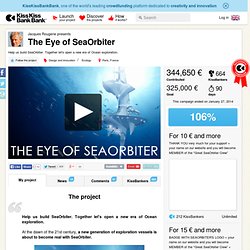

Microplastics 'pose toxic threat to marine biodiversity' 2 December 2013Last updated at 12:58 ET By Mark Kinver Environment reporter, BBC News An estimated 150 million tonnes of plastic is "lost" each year Tiny particles of waste plastic that are ingested by shoreline "eco-engineer" worms may be negatively affecting biodiversity, a study says.

Underwater hotel rooms: Is down becoming the new up? 2 December 2013Last updated at 19:05 ET By Paul Rubens Technology reporter Deep Ocean Technology has designed its rooms to minimise noise on the sea floor When it comes to luxury hotel rooms, down is becoming the new up.

Instead of penthouse suites, the most exclusive accommodation in the house may soon be at the very bottom, 20ft (6m) or more beneath the surface of the sea. Www.risingtidescompetition.com/risingtides/Winners_files/122.220864_KuthRanieri_lr.pdf. This Starship Enterprise Of The Sea Will Launch Its Exploration In 2016. If you want to do deep sea ocean research today, you'll have to take a journey to the Florida Keys, where the world's last remaining underwater research lab, the Aquarius, is housed.

But that's soon about to change. When it's completed, the SeaOrbiter, a spaceship-like underwater vessel, will become the first ocean lab where researchers can live 24/7 over long periods of time. (The Aquarius, in comparison, goes on missions for 10 days on average.) It's the Starship Enterprise of the sea, exploring parts of the ocean where no man has gone before. The $43 million SeaOrbiter project is the result of a 30-year research and design process.
He writes in an email: "The SeaOrbiter is the synthesis of everything that we have been able to do at sea: it is at the same time a moving habitat and a dynamic launching point for submarine research and exploration. The project is currently crowdfunding 325,000 euros so it can begin construction in France in the Spring of 2014.
Jacques Rougerie presents The Eye of SeaOrbiter. The project Help us build SeaOrbiter.

Together let's open a new era of Ocean exploration. At the dawn of the 21st century, a new generation of exploration vessels is about to become real with SeaOrbiter. Drifting with the main oceanic currents, SeaOrbiter will allow a crew of explorers to live 24 hours a day over a long period of time in the heart of the ocean, this vast territory still widely unknown being the last frontier on the planet. With scientific and educational purposes, the international program of this unique vessel is also a powerful communication platform that will allow continuous sharing of pictures, videos and scientific discoveries. This unique project is led by the sea architect and Academician, Jacques Rougerie, surrounded by the world's leading ocean and space experts and supported by, among others, Ifremer, NASA and National Geographic. Since SeaOrbiter is an exploratory, scientific and technological adventure crucial to mankind, we invite you to be part of it.
Earth Observatory : Home. World of Change Satellite images showing how our world— forests, oceans, cities, even the Sun— has changed in recent decades.

Read more Blue Marble Composite satellite images of the entire Earth. Read more Earth at Night The night side of Earth twinkles with light in these composite global and regional views. Experiments Hands-on educational activities. Visible Earth A catalog of NASA images and animations of our home planet. NASA Earth Observations View, download, and analyze imagery of Earth science data. Something fishy is going on in the South Atlantic: Nasa claims mysterious lights seen from space are in fact FISHERMEN boats.
The lights shone in a region were there are no humans, fires or gas wellsNasa says they are caused by fishermen using 300kW lights to catch squidSatellite maps show how the boats hug the borders of the exclusive economic zones where they are allowed to fish By Ellie Zolfagharifard Published: 13:38 GMT, 25 October 2013 | Updated: 19:40 GMT, 25 October 2013 A map of the Earth, released by Nasa last year, revealed something fishy going on off the coast of Argentina.

Around 300 miles offshore, a city of lights was appearing in the middle of the South Atlantic Ocean. The strange lights were perplexing as there are no humans, fires or gas wells in that region. A global composite map of Earth's night lights revealed human activity well offshore from South America What is there however, according to Nasa, are fishing boats with lights powerful enough to be seen in space. The lights were spotted using Visible Infrared Imaging Radiometer Suite on the Suomi NPP satellite. Can The Lowly Oyster Protect New York City From Floods? After massive flooding from Hurricane Sandy last year, New York City Mayor Michael Bloomberg drummed up a $20 billion plan to install permanent and temporary flood protection systems across the city.

Yet these are only partial answers, and the biggest of them--a massive flood gate sealing off New York Harbor during a storm--is likely too expensive and impractical. But a very different type of engineer could help save the day: a gelatinous invertebrate living in the river.